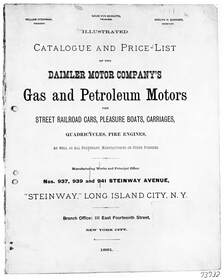Blog Writing
The purpose of a blog is to establish you as the authority in your field. They are not for sales pitches or case stories or news articles (all of which should be presented elsewhere on your web site). Blogs provide your prospects and clients with expert, objective information about issues and opportunities common to your marketplace. If you sell trade show exhibits, for example, your blog should include stories about the design, fabrication, use, potential problems and ultimate impact of these products. Readers will return to your blog again and again because it provides information and perspective they can use - and can't get anywhere else. That positions you as the expert, the company they will turn to when it's time to buy something.
Check out my sample blog about communicating competitive advantage: http://www.brianefaulkner.com/blog

A Mercedes by Another Name
While researching origin of the current Mercedes-Benz tagline, I was reminded how close the car came to being called something else, at least here in America. Were it not for a promising young man’s tragic illness, Mercedes may have been called by a name that had nothing to do with automobiles, a name already well established worldwide by the time Gottlieb Daimler rolled out his high-speed internal combustion-powered automobile in 1886. (Carl Benz created his car during that same year, but the two businesses didn’t come together as Daimler-Benz AG until 1926.) In addition to automobiles, Daimler built engines for boats and industrial applications. That caught the eye of one William Steinway, scion of the famed piano family. Young Steinway was convinced he could sell Daimler’s engines in the United States and so acquired the rights to make and market them for use in such things as cream separators, sewing machines, pumps, ventilating fans, printing presses and other applications that required a single-cylinder stationary engine. On October 6, 1888, the Daimler Motor Company was organized in New York, where Steinway & Sons already had been in business for 35 years. In 1893, Steinway experienced Daimler’s “motor carriage” for himself. Driven by his vision of a motorized America, the piano impresario set about developing his own automobile, one more adapted to American road conditions (he thought Daimler's car too light for the "rough cobblestone streets in this country"). |
“The cars which we intend to produce for the American market will be capable of carrying between two and four people and will be driven by engines with between 2½ and 3½ hp,” Steinway told a newspaper reporter in 1895. “Each car will have four different speed settings: 3½, 6, 9, and 14 miles per hour.”
However, this forward-thinking man’s dream was not to be. He died at age 35 after a stubborn period of undiagnosed illness (probably tuberculosis). By that time he’d invested a frustrating amount of additional capital in the car company to offset its continuing losses, so it’s likely he would have pulled out anyway. After William’s death, Daimler Motor Company’s holdings, including a factory built on Steinway’s land, was sold to newly organized Daimler Manufacturing Company, which in 1905 produced an “American Mercedes” based on the German model. This car was on the market for only eight years before its factory was destroyed by fire. So had William Steinway lived and helped Daimler Motor Company overcome its financial problems, the American Mercedes just might have been called a Steinway, Which probably would have worked out fine, because both brands exemplify the best in their categories to this day. "Best" is subjective, of course, but one way of measuring it is by customer demand. Consider this: Steinway & Sons instruments are the pianos on which the overwhelming number of concert artists choose to perform – or aspire to perform - for year after year after year, as they have since the late nineteenth century. A statistic like this has a way of putting teeth in one's claim to excellence! Steinway's claim to excellence has a similar pedigree. William’s father, Heinrich Engelhard Steinweg, emigrated to New York City from Germany around 1850, founded his business in a Manhattan loft, changed his name to Henry Steinway and set a quality standard that has endured through successive generations. His maxim was “Build the best piano possible. Sell it at the lowest price consistent with quality." |
Although the company has passed through a series of different owners since it was sold to CBS in 1972, Steinway & Sons remains perched at the top of the piano performance hierarchy, is the brand to which other fine pianos are most often compared. The company now is owned by American hedge fund manager John Paulson, a long-time admirer of its products. His stated goal is to assure Steinway & Sons’ “continuing greatness.” Henry and William clearly would have agreed on that.
The most recent Mercedes-Benz tagline also reflects the philosophy of its founder, as well as the quality bedrock on which the brand stands as it moves deeper into the 21st century. You may recall the TV spot where Gottlieb Daimler nods off at his desk and dreams about the Mercedes-Benz of the future, with its now-familiar technology and style. As Daimler is awakened by a lovely assistant, we see a handwritten phrase scratched on the notepad beside him. It is today's tagline, underlined with a flourish: The best or nothing. Though Mercedes-Benz has experienced some quality issues in recent years (not unlike Steinway), the brand is still held in high esteem, as evidenced by frequent references to the “Mercedes of this” and the “Mercedes of that” as marketers of other high-end products compare their offerings to the car with the three pointed star. “In the end, all any of us has is our good name,” a Mercedes ad once declared. That’s true of Mercedes-Benz and true of Steinway. The two vaulted brands that nearly became kissin’ cousins a hundred-odd years ago have prospered -- and will continue to prosper, in no small part, because of the quality foundation put in place by their founders. © by Brian E. Faulkner Read this post and 100+ other samples here: www.brianefaulkner.com/blog/a-mercedes-by-another-name |

